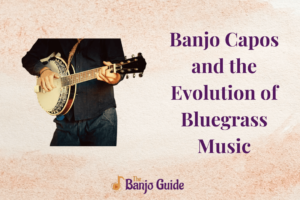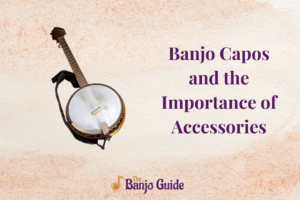The wood and construction of a Savannah Banjo play a huge role in the sound produced by the musical instrument.
The Impact Of Wood On The Sound Of A Savannah Banjo
Different species of wood vary in acid content, oil content, density, resonance, hardness, and more.
There are three types of wood used for the construction of a Savannah Banjo. These are maple, walnut, and mahogany. Here is how each type of wood will vary in the delivery of the result:
- Mahogany:
- The softest hardwood is mahogany.
- It has a softer, warmer sound that distinguishes it.
- The tone has a gentle edge and is warm.
- Mahogany is the best choice for a player who loves a little softer, “sweeter” sound rather than brightness as well as a quick response.
- The way the strings respond to your fingers is just the “response.” The feel of mahogany is slower.
- You get the impression that you’re “drawing the music from the banjo.”
- Maple:
-
-
- A wood with acidity is maple.
- It usually makes a very loud sound and reacts extremely swiftly.
- Quickly is defined as feeling like something pops or snaps as the string is pulled.
- One gets the impression that “the sound pops or snaps right from the banjo.”
- According to one user, “every pluck” was “shattering a glass rod.”
- The sound of maple is distinct and crisp, with a distinct edge. It resembles a crisp, clear snapshot with every detail being razor-sharp.
- Because maple is typically a tougher wood than mahogany, the maple banjos appear louder as a result.
- A portion of the energy from the vibrating strings is absorbed by the softened mahogany neck.
- The banjo’s tone is slightly louder as a result of the increased string vibrations at the bridge caused by the tougher maple neck’s reduced ability to absorb string energy.
- The maple banjo sounds brighter because the tougher neck wood boosts higher frequencies.
-
- Walnut:
-
- Walnut is a solid, acidic wood with a chocolate brown hue that is often tougher than mahogany yet softer, unlike many maples.
- Many banjo players value it for its deep hue.
- Although it doesn’t have the same historical appeal as maple or mahogany, many players adore it.
- It is brighter than mahogany but warmer than maple due to its relative firmness.
- Walnut is the ideal middle ground for players who find mahogany as well as maple a tad warm and bright, respectively.
- Terry Baucom, a legend in the bluegrass banjo world and creator of the Deering Signature banjo, chose straight-grained walnut for his Deering “Terry Baucom signature model.” Terry, dubbed “the Duke of Drive,” fit in perfectly with the contrast of brilliance and warmth.
Now that you know about a different type of woods, their unique characteristics, and how they can have an impact on the sound, let us now focus on the construction aspect and its impact on the sound of a Savannah Banjo.
The Impact Of Construction On The Sound Of A Savannah Banjo
One of the most stereotyped instruments of the music culture is the Savannah Banjo. Read the Savannah banjo review to learn more. Just a couple of strings enable the musician to deliver excellent sound to appeal to the ears of the listener. However, Banjos too, come in a variety of constructions, string configurations, tunings, and materials, some better suitable than others for specific styles and genres.
-
- Banjo Basics:
- The body, or perhaps more precisely the combination of a hollow rim wrapped in a membrane, the head, is what distinguishes a banjo from other instruments.
- Technically, every stringed instrument with this design, which Africans introduced to the Americas, might be referred to by the term “banjo” in this context.
- The tension hoop as well as a metal tone ring, which is commonly made of brass, are used to fasten the head to that same banjo’s wood rim.
- The instrument may have a resonator or else it may have an open back.
- The head, which was previously made of skin but is now typically made of synthetic materials akin to those used for drumheads, is indeed the key to each banjo’s unique sound.
- By switching the head, you can alter the sound.
- It’s common to come across a Mylar head with icing for that bluegrass sound on something like a resonator banjo.
- People frequently experiment with different materials to try to customize the tone of the open-back banjos.
- Banjo Basics:
- Playing Considerations:
-
- When judging a banjo, as with other stringed instruments, sound, and playability must be balanced.
- Keep an eye out for low, continuous movement up and down the neck.
- There should be no harsh edges on the frets.
- The machines should operate smoothly and maintain pitch despite the requirements of a rigorous picking assault.
- Tuning should always be stable.
- The head must be properly tensioned as well as the bridge must be placed properly because the bridge simply floats on the head.
- A banjo could be fairly difficult to play without that. Check your audio for volume, cleanliness, and consistency.
- Other tonal characteristics are highly individual and subjective.
Now that you know how wood and construction have an impact on the sound of Savannah Banjo, you can buy the best Banjo suitable for your musical considerations. We hope you have all the information that you were looking for to guide you in the right direction. All the best!

I own a music instruments shop. My go to instrument is a banjo. My business makes it easier for me to access the instruments from various brands and of various types. I will give my honest opinion here to help out others in choosing the right instrument for them.





